How To Do The Back Squat For Size And Strength
The squat is considered the king of all exercises. Here’s how to get the most out of it.
“Down the road, in a gym far away, a young man was heard to say, ‘No matter what I do, my legs won’t grow!’ He tried leg extensions, leg curls, leg presses, too. Trying to cheat, these workouts he’d do!
From the corner of the gym where the big guys train, through a cloud of chalk and the midst of pain, where the big iron rides high, and threatens lives, where the noise is made with big forty-fives, a deep voice bellowed as he wrapped his knees.
A very big man with legs like trees, laughing as he snatched another plate from the stack, chalked his hands and monstrous back, said, ‘Boy, stop lyin’ and don’t say you’ve forgotten! Trouble with you is, you ain’t been squattin’!’”
This poem might sound like something written by a meathead Dr. Seuss, but it’s been popular among lifters since its first publication in Iron Man magazine in the early-1980s. It highlights how essential the exercise can be for building size and strength.
The back squat is such a foundational lift; it’s the default reference point when people talk about “the squat” — sorry, front squat, it’s just not your day. It’s time to get better acquainted with what some call the king of all exercises. Here’s a complete guide to the barbell back squat.
Back Squat Technique Demo
Coach Traver Boehm demonstrates how to perform the classic back squat. See it in action and then continue reading to learn all the details you need to get the most benefit from this significant movement.
How to Do the Back Squat
The back squat is often the first barbell exercise lifters learn in the gym. It’s a fundamental movement for developing lower body strength, muscle size, and total-body stability.
Competitive powerlifters spend years refining their squat technique for optimal power output, but it doesn’t need to be quite that complicated.
Step 1 — Get Under the Bar
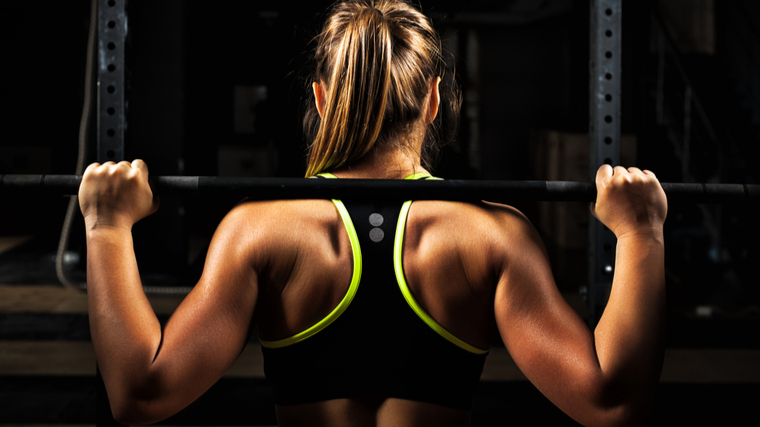
Set a barbell in a rack at mid-chest height. Grab the bar wider than your shoulders with a palms-down grip. Set your feet in front of the bar, bend your knees, and duck down to place the bar across the top of your shoulder blades or the backs of your shoulders. Squeeze the bar with your hands and pinch your shoulder blades together. Make sure your elbows are angled down, not straight back.
Form Tip: You may need to adjust the bar height slightly to your comfort, but you should not be able to stand fully upright with the bar remaining in the rack.
Step 2 — Unrack the Bar and Set Your Stance
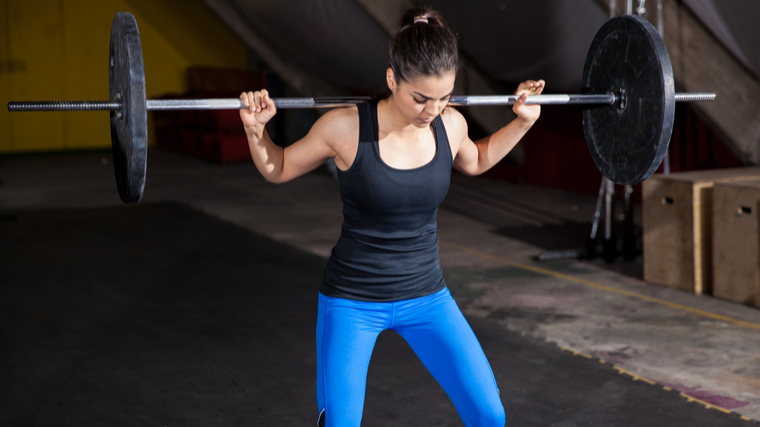
Flex your abs and straighten your legs to lift the bar out of the rack. Keep your shoulder blades retracted and your back straight. Pause briefly to let the weight “settle” onto your muscles. Take one or two small steps backward, and one or two small steps to widen your stance more than shoulder-width apart. Your toes should be pointed at a slight angle outwards. Take a breath and pause to regain total-body tightness.
Form Tip: Your feet should remain flat on the floor when unracking the bar. If you rise onto your toes, the bar is set too high in the rack, reducing stability and increasing the chance of an ankle or knee injury.
Step 3 — Squat Down
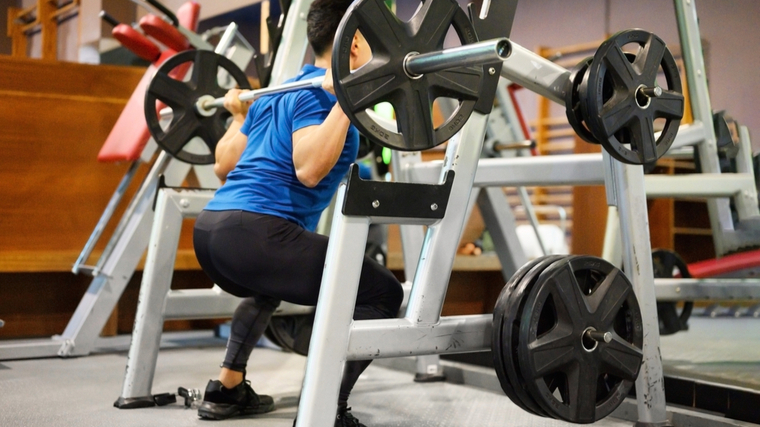
Pull the bar into your upper back and tense your abs to encourage upper body tightness. Maintain a neutral spine and look straight ahead. Keep your feet flat while pushing your hips back. Squat down until your thighs are roughly parallel to the ground. This depth is an effective balance for building strength and power, and stimulating muscle growth. (1)
Form Tip: Descend at a controlled speed. Dropping quickly into the squat or trying to bounce out of the bottom can increase joint strain and decrease muscle recruitment.
Step 4 — Stand Up to Lockout
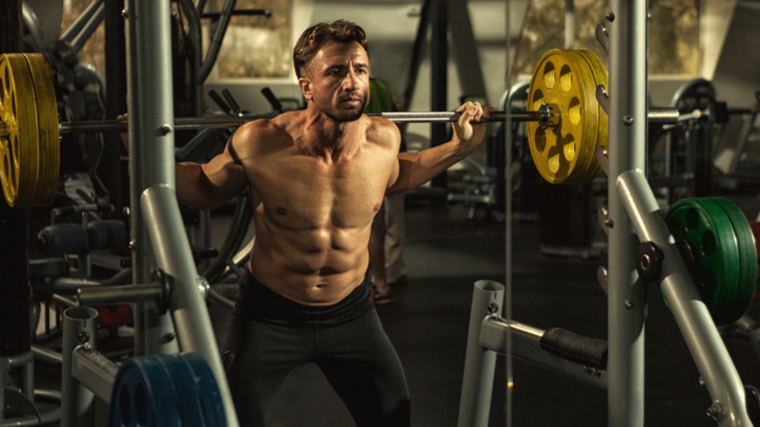
Squeeze the bar tight as you drive your feet into the ground to rise from the bottom. Your hips and shoulders should move up at the same time. This ensures balanced muscle recruitment from your legs, lower back, abs, and upper back; and a safer, stronger lift. In the top position, flex your abs, glutes, and quads to ensure a complete lockout.
Form Tip: If your hips rise before your upper back, you’re not keeping your core tight. Focus on building strength in your abs and lower back, and reduce the weight used for squatting until you can maintain a proper position.
Back Squat Mistakes to Avoid
As popular and widespread as squats are, several common mistakes can limit muscle growth, decrease strength gains, and increase the risk of injury.
Rounding Your Back
Maintaining a neutral spine position is essential for strength and stability in almost any exercise. A rounded back reduces activation of the spinal erectors (the lower back muscles) and increases strain on the vertebral discs.
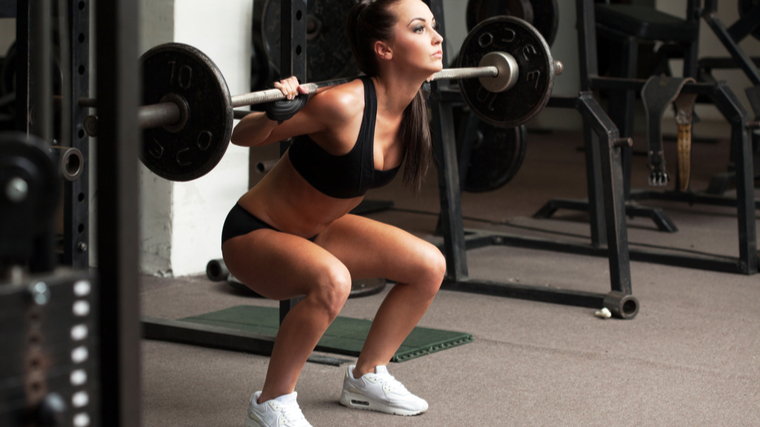
In particular, rounding your back can be extremely dangerous with the squat because your back muscles support the load. The shearing stress of the barbell can increase dramatically if the movement is performed with a rounded back.
Avoid It: Driving your elbows under the bar to keep your upper back engaged. Keep your abs tense as you descend and stand.
Using a Short Range of Motion
You can manipulate the range of motion of your squat as a training technique, but performing squats with a short range of motion is more often done unintentionally, under the guise of “proper form.”
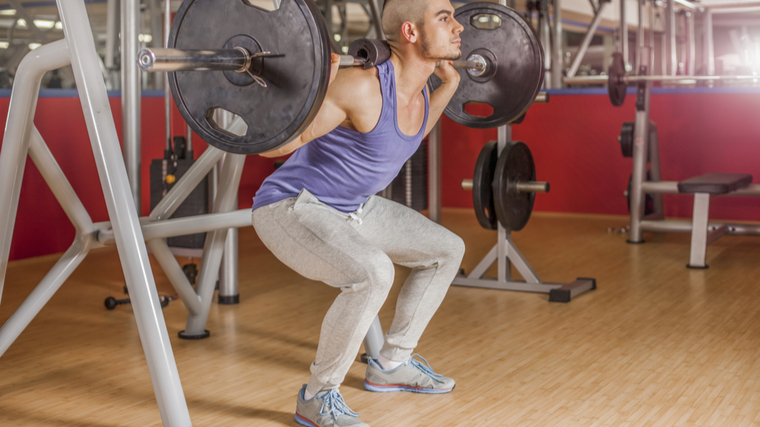
Squatting until your thighs are parallel to the ground has been shown to build more leg muscle than squatting to higher depths. (2) For maximum training efficiency, use parallel-depth as a minimum target.
If you’re a competitive powerlifter, squatting to parallel is required. Otherwise, your lift doesn’t count.
Avoid it: Maintain body awareness and monitor your technique throughout each rep. If necessary, reduce the weight on the bar to ensure consistent depth on each set.
Caving in Your Knees
Allowing your knees to wobble in or out during a squat increases strain on the knee joint. If your knees cave inwards as you squat, it’s often a sign of muscular imbalances or weak glutes due to how various muscles interact with the thigh and pull across the knee joint.
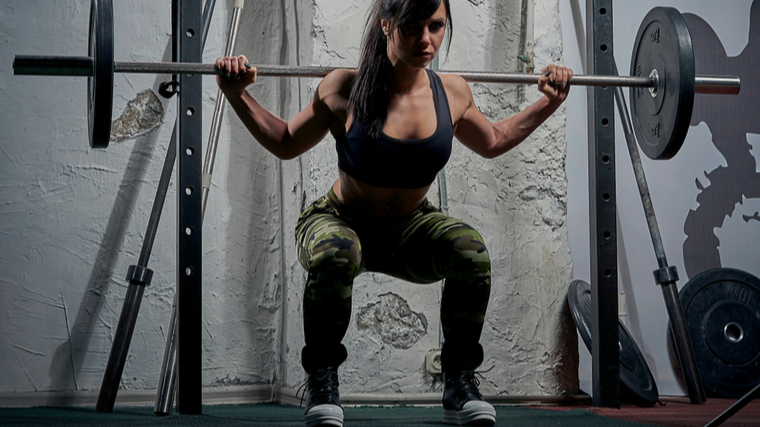
Avoid it: Experiment with adjusting your stance since squatting too wide or narrow may affect your knee position. Focus on driving your knees outward when rising from the bottom position of a squat. Incorporate glute-strengthening exercises like Romanian deadlifts and hip thrusts.
Benefits of the Back Squat
You don’t build a reputation as “the king of all exercises” if you don’t bring some serious gains to the table.
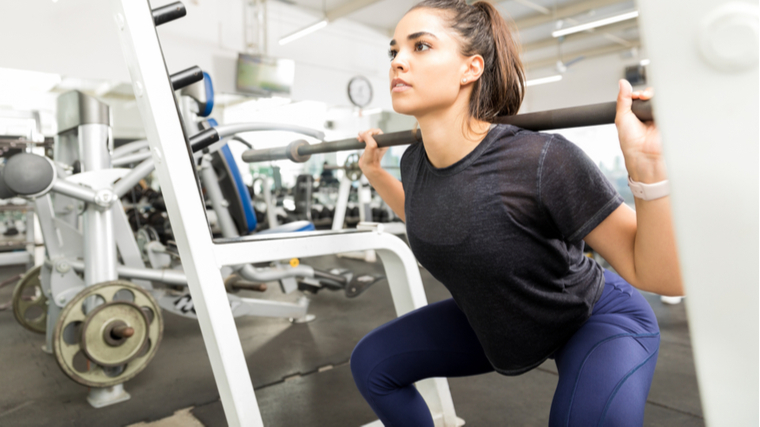
The back squat builds size and strength in multiple body parts, predominantly your legs, while your core and upper back are heavily recruited to stabilize the weight. And that’s not to mention the mental toughness and grit developed from consistently squatting heavy.
Lower Body Strength
The back squat is one of the Big Three powerlifts; it’s a test of strength for the entire lower body. The exercise recruits all the muscles of the legs for some serious power output and the ability to move very heavy weights.
Leg Size
Some lifters believe the back squat is the only exercise you need to build a muscular set of legs. While that type of approach is debatable, it has some credible roots. The back squat significantly recruits the quadriceps and glutes, while the hamstrings are recruited relatively less. (3)
Muscles Worked by the Back Squat
The back squat is one of the most complete lower body exercises you can perform with a barbell. It fully engages the legs, activates the core, and involves the upper body for stability.
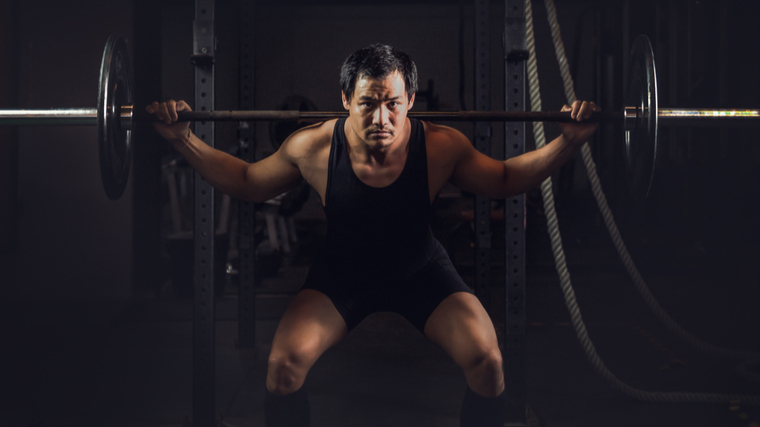
Here’s a closer look at the muscles involved.
Quadriceps
The quads, found on the front of your thighs, are primarily responsible for straightening the leg. During the back squat, the quads are heavily activated when transitioning out of the bottom position as well as closer to lockout.
The quad muscles are also the largest on the leg and contribute to most leg size. While the quadriceps muscle is composed of four different heads, there’s no significant way to emphasize one head over the other to result in visibly different muscle growth.
Glutes
The glutes are a series of three gluteus muscles that work together to manipulate the leg at the hip joint. Primarily, the glutes are responsible for hip extension — bringing the legs into a straight line with the upper body.
During squats, the glutes are put under a significant stretch in the bottom position and are maximally contracted at lockout in the top position.
Hamstrings
The hamstrings, on the back of your thighs, are responsible for bending your legs and extending your hips (similar to the glutes). They also play a role in knee health.
The squat works your hamstrings during the descent and transition out of the bottom position. The hamstrings are activated during the squat but not significantly compared to the deadlift. This is why squats are typically considered a “quad exercise” while deadlifts are considered a “hamstring exercise.”
Upper Back
The entire upper back, composed of multiple muscles like the trapezius, rhomboids, teres, and rear deltoids (shoulders), works to control your shoulder blades. The upper back is heavily recruited to maintain the barbell position during squats.
Even though the upper back doesn’t move through any significant range of motion during the squat because your shoulder blades should be kept pinched together throughout the set, intense isometric contractions have been shown to build size and strength. (4)
Spinal Erectors
The spinal erectors are a long pair of muscles running the length of your spine, from your tailbone to the base of your neck. The lower section of the spinal erectors are the “lower back muscles.”
They are responsible for bending your torso sideways and backward, rotating, and resisting forward bending. During squats, your spinal erectors should act as stabilizers to keep your upper body straight. If they’re not strong enough, your back will round forward.
Abs
The rectus abdominis is the primary ab muscle across the front of your body — the coveted six-pack. The abs control torso flexion, or bending forward. They also work to provide static support and stability throughout the entire upper body.
The abs are under significant muscular stress to maintain a stable upper body while squatting. Like the lower back, if your abs are weak, you’ll find yourself rounding forward.
Who Should Do the Back Squat
The back squat can serve a purpose in nearly every lifter’s training program. Its wide range of benefits can be applied to multiple goals and lifters with various experience levels.
Strength Athletes
Competitive powerlifters should perform the back squat because it’s one of the powerlifts. CrossFit athletes, strongmen and strongwomen, Olympic weightlifters, and other strength-based competitors will also benefit from building complete lower-body strength with squats.
General Sports Athletes
Any sport that requires an athlete to run or jump can benefit from squats. From baseball to volleyball and everything in between, squats help to develop strength and power that transfers to performance on the field.
Physique-Focused Lifters
Squats are invaluable for building muscle in the legs. Whether you’re getting on stage in a physique competition or you’ve just decided to add an inch or two to your legs for fun, squatting can be the difference between reaching your goal or missing out.
How to Program the Back Squat
The back squat is often the cornerstone of lower body workouts. It’s almost always the first exercise done on leg day, and it tends to be an exercise lifters approach with trepidation because of the intense strain and total-body challenge.
Heavy Weight, Low Repetition
Squatting heavy weight for low reps is a classic way to build serious leg strength. A scheme of Three to five sets of three to five reps is hard to beat for power and strength. Be sure to keep your depth consistent. Don’t fall into the trap of squatting higher and higher as the weights get heavier and heavier. Make sure to lift slightly more weight than you did the week prior.
Moderate Weight, Moderate Repetition
To pack on leg size, train squats with a time-tested bodybuilding approach — four to five sets of eight to 12 reps. The higher volume is associated with triggering more significant muscle growth. (5)
Breathing Squats
Some lifters consider this old school approach to training a rite of passage. It can be traced back nearly a century to lifters in the early-1900s who trained with high-rep squats using a unique breathing pattern throughout the set.
Perform one set of 20 reps. The key, however, is to take two or three deep breaths between each repetition. On the one hand, the breaths allow you a very brief rest to focus on one perfect repetition after the next, rather than performing a non-stop series of reps. On the other hand, it’s not uncommon for one set to take several minutes to complete. This is why it’s considered by many to be one of the most challenging squat workouts of all time.
Back Squat Variations
The back squat with a low-bar position is a versatile movement for building size and strength while learning the basic squat pattern. However, not every lifter is ready or able to perform a low-bar squat with good technique, whether it’s due to mobility issues, limb leverages, or other factors. Here’s how to get similar benefits with a bar on your back.
High-Bar Squat
The high-bar squat is incredibly similar to the low-bar squat. Expectedly, the critical difference is the barbell’s position on your back. The high bar places the weight slightly higher on your traps, which starts a cascade of subtle but significant technique changes due to the slightly different leverage.
Your upper body will be more vertical, your stance can often be closer, and the overall muscle recruitment will be slightly different. Most significantly, high-bar squats can reduce lower back strain compared to low-bar squats because your lower back is less involved in the lift due to the upright torso position.
Anderson Squat
Sometimes called a pin squat or a bottoms-up squat, the Anderson squat was popularized by legendary weightlifter and powerlifter Paul Anderson. This movement begins the lift from a dead-stop position, with the bar resting fully on the rack supports, which requires increased muscle recruitment, mobility, and perfect technique to get the weight moving.
Anderson squats are often done with a deliberately shortened range of motion to target key zones where a lifter’s strength may stall. This is one of the exceptions to the “always use a full range of motion” rule because it’s done with intention, not accidentally.
Safety Bar Squat
The safety bar is a unique and specialized bar found in many gyms’ corners. The thick pad raises the bar slightly above your traps and upper back, which shifts the weight’s center of gravity and significantly increases upper back recruitment.
The key benefits are improved upper back strength since the weight will try to “push” your upper back down, which you must resist throughout the movement. The safety bar also drastically reduces shoulder strain and shoulder mobility requirements because the handles allow a more natural grip.
Back Squat Alternatives
Some lifters may be unable to perform the low-bar squat due to pre-existing lower back issues, shoulder mobility problems, or other factors that require individual attention. Here are the best alternatives that build similar leg size and strength.
Front Squat
The front squat is one of the most common alternatives to the back squat. By supporting the bar on the fronts of the shoulders instead of across the upper back, you significantly reduce stress on the lower back because you can maintain a more upright torso (even more so than with high-bar squats).
Front squats are also shown to reduce strain on the knee joints compared to back squats, making it a potentially better option for lifters with any type of joint issue. (6)
Trap Bar Squat
The terms “trap bar squat” and “trap bar deadlift” are sometimes used interchangeably because the exercises appear nearly identical. However, like the low-bar and high-bar squat are subtly but significantly different, so are the trap bar movements.
Focus on keeping your shoulders pulled back and your upper body vertical. Resist the urge to hinge forward at the hips, which recruit more glutes and hamstrings and turn the exercise into a deadlift.
Leg Press
Sometimes the best alternative to a squat is not to squat. The leg press delivers comparable muscle-building benefits. The supported seat nearly eliminates upper body involvement, making it ideal for lifters with shoulder, elbow, or lower back issues.
Two keys are to maintain contact between your hips and low back with the seat at all times. Don’t lower the weight so far that your hips curl up — this would put the lower back under immediate dangerous strain. Secondly, like squats, never trade range of motion for added weight. Overloading the weight sled and reducing the range of motion is generally counterproductive.
FAQs
My stance doesn’t feel right during the movement. I feel stress in my joints, not my muscles. How do I fix it?
One’s squat stance is something that should be fine-tuned to the individual. Begin with your feet slightly wider than shoulder-width and angled slightly outward. If that’s uncomfortable on your hips, knees, or ankles, experiment until you find a stance that makes the movement feels smooth and natural.
One “hack” to discovering the right stance is to jump high into the air two or three times. On the final jump, stick the landing and quickly look at your feet. That’s roughly where your body “wants” to perform from because it’s where you naturally landed to absorb and re-apply force. Memorize that foot position and try to replicate it in the gym.
I’ve read that every “serious” lifter should include back squats in their program. Is that true?
No, it’s not true. Every competitive powerlifter should include back squats because it’s one of the three lifts they perform in a meet. For everyone else in the gym, there is no such thing as a mandatory exercise.
Sure, plenty of reasons to perform back squats have been explained throughout this article. But a handful of equally effective squat variations can be done instead. Focus on choosing the most effective exercises for your specific goals and your individual needs (based on things like your limb length, previous injuries, current mobility, etc.).
And Now, You Know Squat
“If you could only do one exercise for the rest of your life, what’d it be?” That’s a popular thinking exercise many lifters consider. Considering its versatility and effectiveness, “I’d just squat” is always going to be a safe answer. It’s an ideal movement for beginners establishing a base of strength and muscle, and it’s a time-tested classic for anyone looking to reconnect with one of the oldest and most revered exercises in the training world.
References
- Clark, D. R., Lambert, M. I., & Hunter, A. M. (2012). Muscle activation in the loaded free barbell squat: a brief review. Journal of strength and conditioning research, 26(4), 1169–1178. https://doi.org/10.1519/JSC.0b013e31822d533d
- Kubo, K., Ikebukuro, T., & Yata, H. (2019). Effects of squat training with different depths on lower limb muscle volumes. European journal of applied physiology, 119(9), 1933–1942. https://doi.org/10.1007/s00421-019-04181-y
- Ribeiro, Alex & Santos, Erick & Nunes, João Pedro & Amarante do Nascimento, Matheus & Graça, Ágatha & Bezerra, Ewertton & Mayhew, Jerry. (2022). A Brief Review on the Effects of the Squat Exercise on Lower-Limb Muscle Hypertrophy. Strength and Conditioning Journal. Publish Ahead of Print. 10.1519/SSC.0000000000000709.
- Oranchuk, D. J., Storey, A. G., Nelson, A. R., & Cronin, J. B. (2019). Isometric training and long-term adaptations: Effects of muscle length, intensity, and intent: A systematic review. Scandinavian journal of medicine & science in sports, 29(4), 484–503. https://doi.org/10.1111/sms.13375
- Schoenfeld, B. J., Contreras, B., Krieger, J., Grgic, J., Delcastillo, K., Belliard, R., & Alto, A. (2019). Resistance Training Volume Enhances Muscle Hypertrophy but Not Strength in Trained Men. Medicine and science in sports and exercise, 51(1), 94–103. https://doi.org/10.1249/MSS.0000000000001764
- Gullett, Jonathan C; Tillman, Mark D; Gutierrez, Gregory M; Chow, John W A Biomechanical Comparison of Back and Front Squats in Healthy Trained Individuals, Journal of Strength and Conditioning Research: January 2009 – Volume 23 – Issue 1 – p 284-292 doi: 10.1519/JSC.0b013e31818546bb
Featured Image: antoniodiaz / Shutterstock
